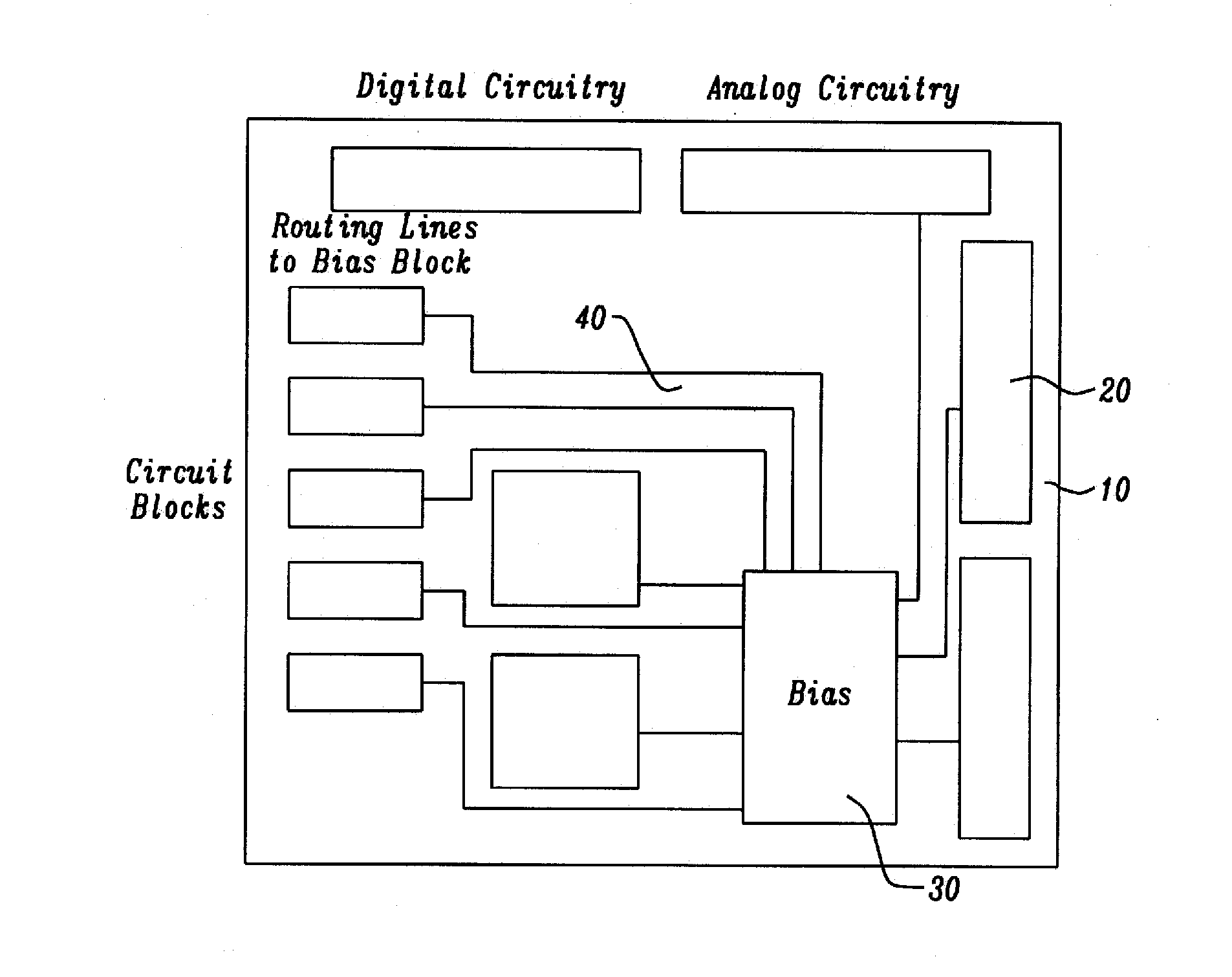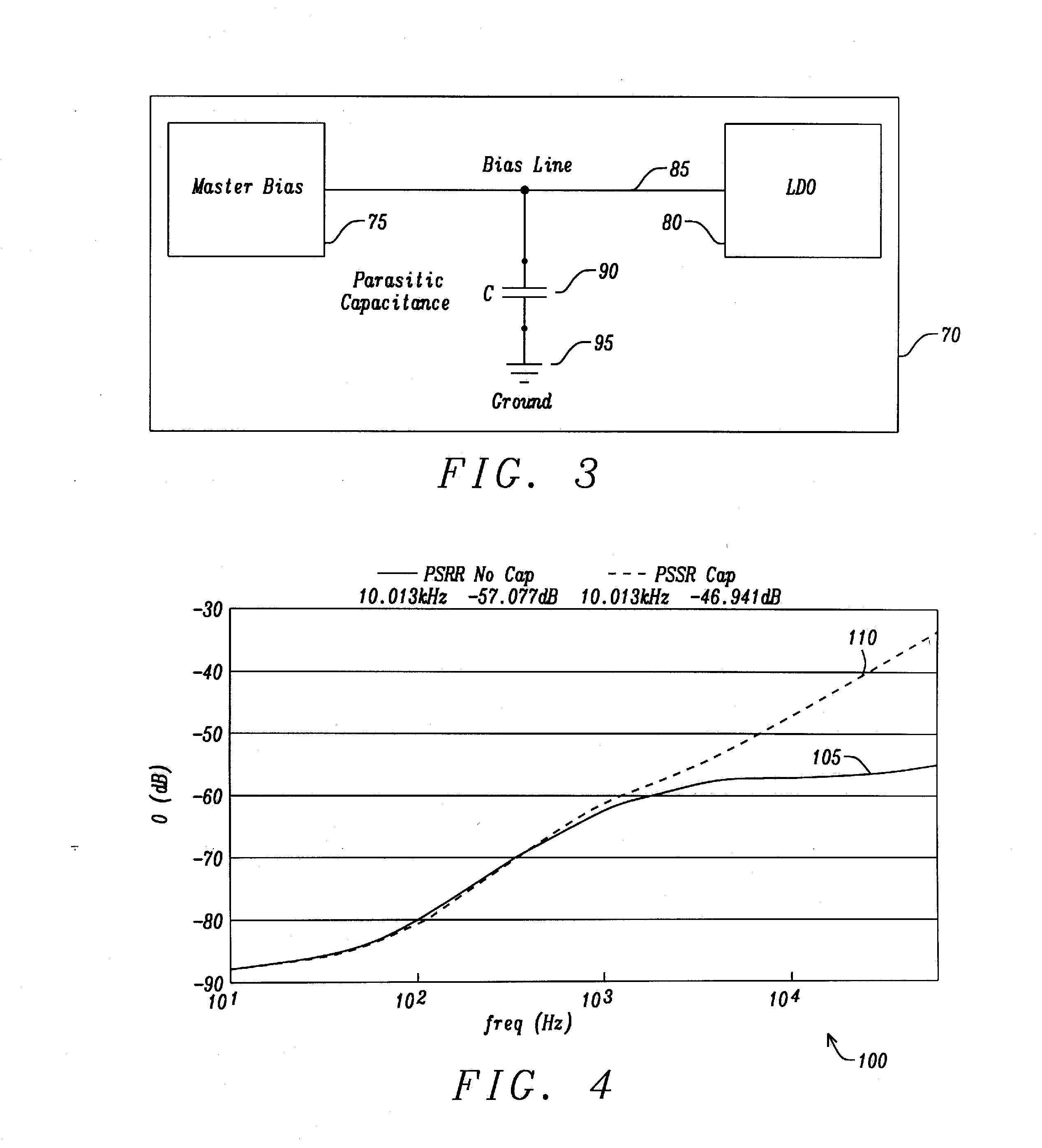Apparatus and Method for a Voltage Regulator with Improved Power Supply Reduction Ratio (PSRR) with Reduced Parasitic Capacitance on Bias Signal Lines
a voltage regulator and parasitic capacitance technology, applied in the field of linear voltage regulator circuits, can solve the problems of large capacitance, large noise, and high impedance of bias lines, and achieve the effect of lessening the impact of parasitic capacitan
- Summary
- Abstract
- Description
- Claims
- Application Information
AI Technical Summary
Benefits of technology
Problems solved by technology
Method used
Image
Examples
first embodiment
[0040]FIG. 6 is a circuit schematic diagram illustrating the internal connections from the bias current from the bias block to the low drop out (LDO) regulator in accordance with the disclosure. The circuit contains an n-channel MOSFET switch N1120. The n-channel MOSFET switch N1120 enables the flow of bias current to the low dropout (LDO) when the LDO is in an enable mode of operation. The circuit contains a p-channel MOSFET 130 between the battery voltage 135, and the n-channel MOSFET switch Ni 120. A bias current generator 140 represents the circuit bias between n-channel MOSFET 120 and ground connection 150. A circuit 200 is represented by Il controls the gate of n-channel MOSFET N1120. The circuit 200 is electrically connected to regulated power supply 210. With the electrical connection to VREG, the circuit utilizes a ripple free / regulated / filtered supply. The ENABLE function enters the network as a input to circuit element 220. Parasitic capacitance associated with n-channel ...
second embodiment
[0043]FIG. 8 is a circuit schematic diagram illustrating the internal connections from the bias current from the bias block to the low drop out (LDO) regulator in accordance with the disclosure. The circuit contains an n-channel MOSFET switch N1120. The n-channel MOSFET switch N1120 enables the flow of bias current to the low dropout (LDO) when the LDO is in an enable mode of operation. The circuit contains a p-channel MOSFET 130 between the battery voltage 135, and the n-channel MOSFET switch N1120. A bias current generator 140 represents the circuit bias between n-channel MOSFET 120 and ground connection 150. A circuit 160 is represented by I1 is electrically connected to the power supply 135. The ENABLE function enters the network as an input to circuit element 162. Parasitic capacitance associated with n-channel MOSFET 120 are gate-to-drain capacitance 121, gate-to-source capacitance 122, and source-to-drain capacitance 123. Parasitic capacitance from the routing line 165 to gro...
fourth embodiment
[0046]FIG. 10 is a circuit schematic diagram illustrating the internal connections from the bias current from the bias block to the low drop out (LDO) regulator in accordance with the disclosure. The circuit contains a p-channel MOSFET switch PFET 310. The p-channel MOSFET switch 310 enables the flow of bias current to the low dropout (LDO) when the LDO is in an enable mode of operation. The circuit contains a bias current network 280 between the battery voltage 135, and the p-channel MOSFET switch 310. A “On MOSFET” NFET N2290 is electrically connected bias between n-channel MOSFET 120 and ground connection 150. A digital gate 220 is represented by I1 which is driven of the LDO supply and controls the gate of p-channel MOSFET 310 and is electrically connected to the regulated voltage supply 300. With the electrical connection to the regulated voltage supply, the circuit utilizes a ripple free / regulated / filtered supply. The ENABLE function enters the network as an input to circuit e...
PUM
 Login to View More
Login to View More Abstract
Description
Claims
Application Information
 Login to View More
Login to View More - R&D
- Intellectual Property
- Life Sciences
- Materials
- Tech Scout
- Unparalleled Data Quality
- Higher Quality Content
- 60% Fewer Hallucinations
Browse by: Latest US Patents, China's latest patents, Technical Efficacy Thesaurus, Application Domain, Technology Topic, Popular Technical Reports.
© 2025 PatSnap. All rights reserved.Legal|Privacy policy|Modern Slavery Act Transparency Statement|Sitemap|About US| Contact US: help@patsnap.com



